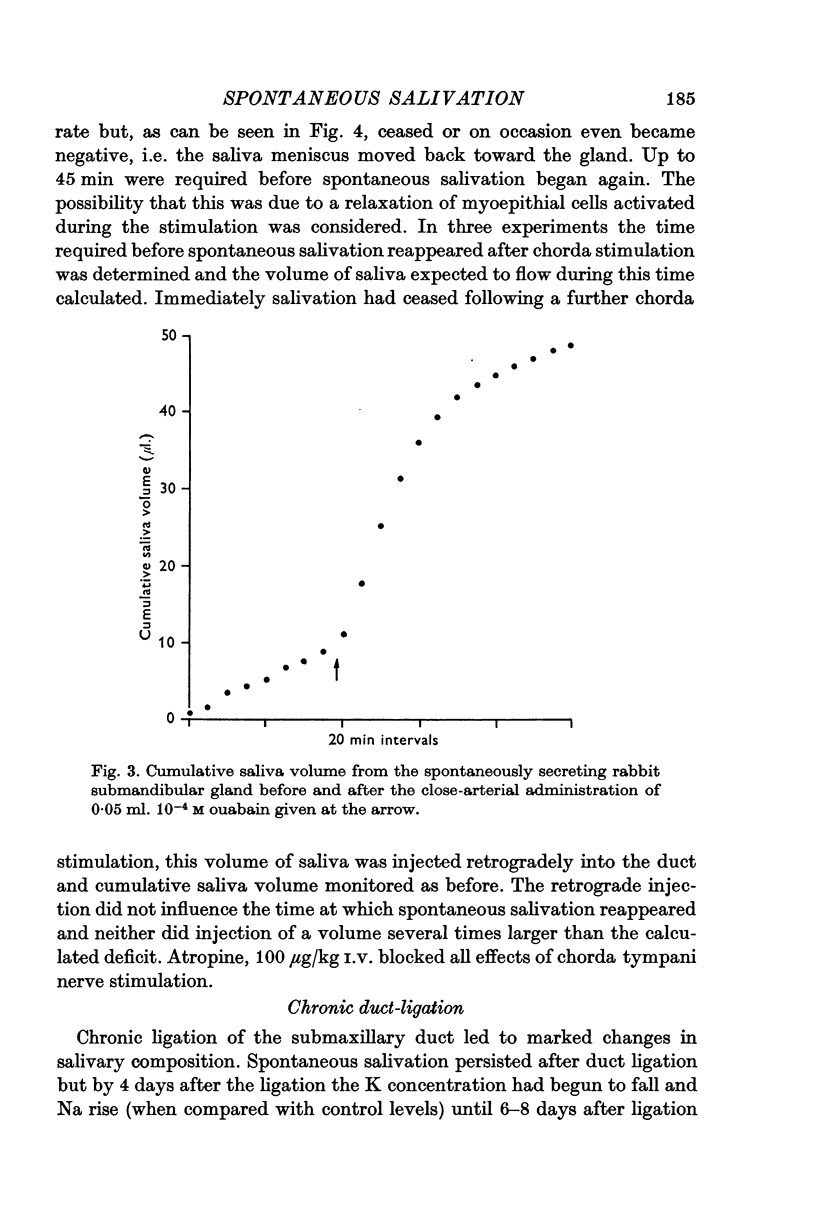Abstract
1. Salivation has been studied in the submandibular gland of the rabbit. A very slow spontaneous salivation took place when all possibility of nerve influence had been excluded. Salivation was not due to ultrafiltration.
2. The `spontaneous' saliva had a mean K concentration of 148 mM and Na concentration of 46 mM. With increasing salivation rate produced by parasympathetic nerve stimulation, K concentration fell to a plateau level of about 30 mM whilst Na concentration fell rapidly to reach the low value of 3 mM, then began to rise again at the higher flow rates.
3. Ligation of the submandibular duct produced a reversal of the ion concentrations in spontaneous saliva. By 4 days K concentration was lower and that of Na higher than control values until by 2 weeks the effect was maximal with mean concentrations of 25 mM for K and 153 mM for Na.
4. Ouabain increased the spontaneous salivation rate and ethacrynic acid slowed or prevented it altogether. On the basis of the known sites of action of these drugs it is postulated that two pumps are involved in the regulation of spontaneous salivation. There appears to be basal activity of an acinar mechanism pumping NaCl into the lumen, taking water with it. This pump is activated directly or indirectly by the intracellular Na concentration which itself is controlled by an Na—K exchange pump.
5. Excitation of the sympathetic trunk produced a small, though definite, increase in salivation rate. There was evidence that myoepithelial cells might also be involved in the sympathetic response and that they were activated by α receptor stimulation. Salivation evoked by sympathetic nerve stimulation would seem to be a response to β receptor stimulation, but the possibility that activation of both α and β receptors was required could not be excluded entirely.
Full text
PDF














Selected References
These references are in PubMed. This may not be the complete list of references from this article.
- AHLQUIST R. P., LEVY B. Andrenergic receptive mechanism of canine ileum. J Pharmacol Exp Ther. 1959 Oct;127:146–149. [PubMed] [Google Scholar]
- BURGEN A. S. The secretion of potassium in saliva. J Physiol. 1956 Apr 27;132(1):20–39. doi: 10.1113/jphysiol.1956.sp005500. [DOI] [PMC free article] [PubMed] [Google Scholar]
- Darke A. C., Smaje L. H. Dependence of functional vasodilatation in the cat submaxillary gland upon stimulation frequency. J Physiol. 1972 Oct;226(1):191–203. doi: 10.1113/jphysiol.1972.sp009980. [DOI] [PMC free article] [PubMed] [Google Scholar]
- Darke A. C., Smaje L. H. Myoepithelial cell activation in the submaxillary salivary gland. J Physiol. 1971 Dec;219(1):89–102. doi: 10.1113/jphysiol.1971.sp009651. [DOI] [PMC free article] [PubMed] [Google Scholar]
- Emmelin N., Garrett J. R., Ohlin P. Motor nerves of salivary myoepithelial cells in dogs. J Physiol. 1969 Feb;200(2):539–546. doi: 10.1113/jphysiol.1969.sp008706. [DOI] [PMC free article] [PubMed] [Google Scholar]
- Emmelin N., Garrett J. R., Ohlin P. Neural control of salivary myoepithelial cells. J Physiol. 1968 May;196(2):381–396. doi: 10.1113/jphysiol.1968.sp008513. [DOI] [PMC free article] [PubMed] [Google Scholar]
- Emmelin N., Holmberg J. The presence of beta-receptors in the submaxillary gland of the dog. Br J Pharmacol Chemother. 1967 Jun;30(2):371–378. doi: 10.1111/j.1476-5381.1967.tb02143.x. [DOI] [PMC free article] [PubMed] [Google Scholar]
- Emmelin N., Ohlin P., Thulin A. The pharmacology of salivary myoepithelial cells in dogs. Br J Pharmacol. 1969 Nov;37(3):666–679. doi: 10.1111/j.1476-5381.1969.tb08505.x. [DOI] [PMC free article] [PubMed] [Google Scholar]
- Mangos J. A., Braun G. Excretion of total solute, sodium and potassium in the saliva of the rat parotid gland. Pflugers Arch Gesamte Physiol Menschen Tiere. 1966;290(2):184–192. doi: 10.1007/BF00363695. [DOI] [PubMed] [Google Scholar]
- Martinez J. R., Holzgreve H., Frick A. Micropuncture study of submaxillary glands of adult rats. Pflugers Arch Gesamte Physiol Menschen Tiere. 1966;290(2):124–133. doi: 10.1007/BF00363690. [DOI] [PubMed] [Google Scholar]
- NORDENFELT I., OHLIN P. Supersensitivity of salivary glands of rabbits. Acta Physiol Scand. 1957 Nov 26;41(1):12–17. doi: 10.1111/j.1748-1716.1957.tb01506.x. [DOI] [PubMed] [Google Scholar]
- Petersen O. H. Formation of saliva and potassium transport in the perfused cat submandibular gland. J Physiol. 1971 Jul;216(1):129–142. doi: 10.1113/jphysiol.1971.sp009513. [DOI] [PMC free article] [PubMed] [Google Scholar]
- Petersen O. H. Initiation of salt and water transport in mammalian salivary glands by acetylcholine. Philos Trans R Soc Lond B Biol Sci. 1971 Aug 20;262(842):307–314. doi: 10.1098/rstb.1971.0096. [DOI] [PubMed] [Google Scholar]
- Petersen O. H. Some factors influencing stimulation-induced release of potassium from the cat submandibular gland to fluid perfused through the gland. J Physiol. 1970 Jun;208(2):431–447. doi: 10.1113/jphysiol.1970.sp009129. [DOI] [PMC free article] [PubMed] [Google Scholar]
- SCHNEYER C. A., SCHNEYER L. H. Secretion by salivary glands deficient in acini. Am J Physiol. 1961 Nov;201:939–942. doi: 10.1152/ajplegacy.1961.201.5.939. [DOI] [PubMed] [Google Scholar]
- Whittembury G., Proverbio F. Two modes of Na extrusion in cells from guinea pig kidney cortex slices. Pflugers Arch. 1970;316(1):1–25. doi: 10.1007/BF00587893. [DOI] [PubMed] [Google Scholar]
- YOSHIMURA H., INOUE T., IMAI Y., YOSHIMURA F. Studies on mechanism of salivary secretion. Jpn J Physiol. 1962 Oct 15;12:467–483. doi: 10.2170/jjphysiol.12.467. [DOI] [PubMed] [Google Scholar]
- Young J. A., Frömter E., Schögel E., Hamann K. F. A microperfusion investigation of sodium resorption and potassium secretion by the main excretory duct of the rat submaxillary gland. Pflugers Arch Gesamte Physiol Menschen Tiere. 1967;295(2):157–172. doi: 10.1007/BF00362747. [DOI] [PubMed] [Google Scholar]
- Young J. A., Schögel E. Micropuncture investigation of sodium and potassium excretion in rat submaxillary saliva. Pflugers Arch Gesamte Physiol Menschen Tiere. 1966;291(1):85–98. doi: 10.1007/BF00362654. [DOI] [PubMed] [Google Scholar]


